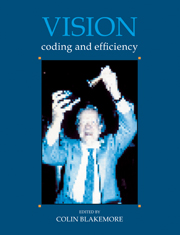Book contents
- Frontmatter
- Contents
- List of Contributors
- Preface
- Reply
- Acknowledgements
- Concepts of coding and efficiency
- 1 The quantum efficiency of vision
- 2 Coding efficiency and visual processing
- 3 Statistical limits to image understanding
- 4 The theory of comparative eye design
- Efficiency of the visual pathway
- Colour
- Brightness, adaptation and contrast
- Development of vision
- Depth and texture
- Motion
- From image to object
- Index
3 - Statistical limits to image understanding
Published online by Cambridge University Press: 05 May 2010
- Frontmatter
- Contents
- List of Contributors
- Preface
- Reply
- Acknowledgements
- Concepts of coding and efficiency
- 1 The quantum efficiency of vision
- 2 Coding efficiency and visual processing
- 3 Statistical limits to image understanding
- 4 The theory of comparative eye design
- Efficiency of the visual pathway
- Colour
- Brightness, adaptation and contrast
- Development of vision
- Depth and texture
- Motion
- From image to object
- Index
Summary
Introduction
Many visual decisions are fundamentally statistical in nature. This can be because of noisy physical processes such as quantum fluctuations (Rose, 1948; Barlow, 1962), or the indeterminacy of the environmental causes of the images on the eye's retinae. The problem with noisy imaging is that a single source can give rise to many images. The challenge is to integrate image information in such a way as to discount the noise. The problem with indeterminacy of the environmental causes of the image is that there are too many possible scene descriptions that could have given rise to the image data. If one can find a statistical description of a visual task, one can often devise an observer that handles both of these types of uncertainty optimally. This ideal observer is one that makes optimal use of the data available, given a statistical description of the task, and a criterion to satisfy (e.g. minimal classification error). The ideal observer comprises a quantitative computational theory for a given task, in the sense of Marr (1982), and as such is an abstract model of the information processing requirements of the task, independent of the particular algorithm or implementation. The statistical approach to understanding biological vision, thus, involves three parts: (1) formulate the statistically optimal observer for a visual task; (2) devise a biological or psychophysical model of performance; (3) compare experimental data to ideal and model. Typically, one compares the biological model with the data, leaving out an analysis of the statistical requirements imposed by the task as specified by an ideal observer.
- Type
- Chapter
- Information
- VisionCoding and Efficiency, pp. 32 - 44Publisher: Cambridge University PressPrint publication year: 1991
- 2
- Cited by



